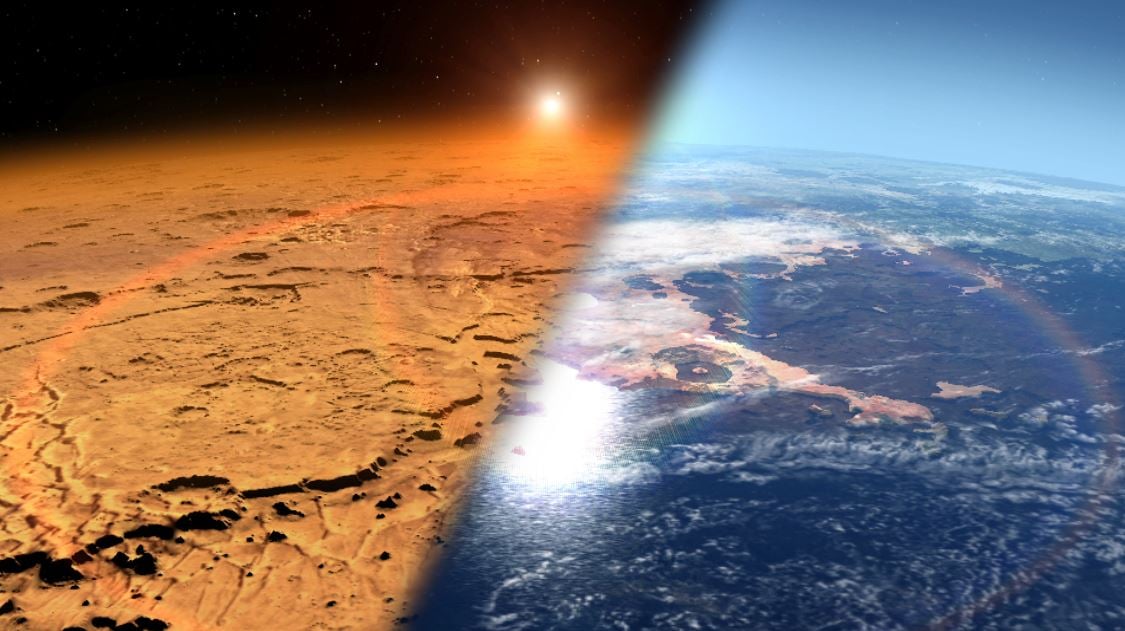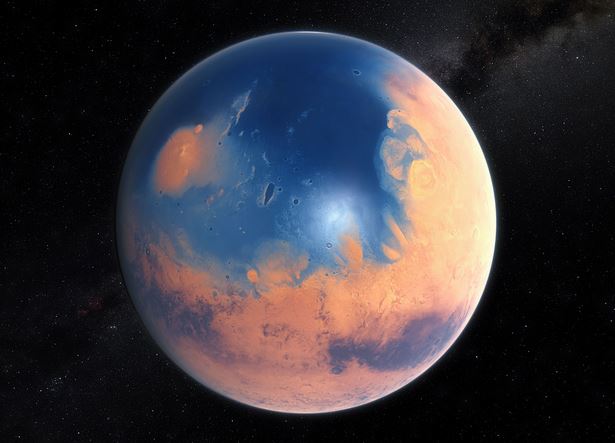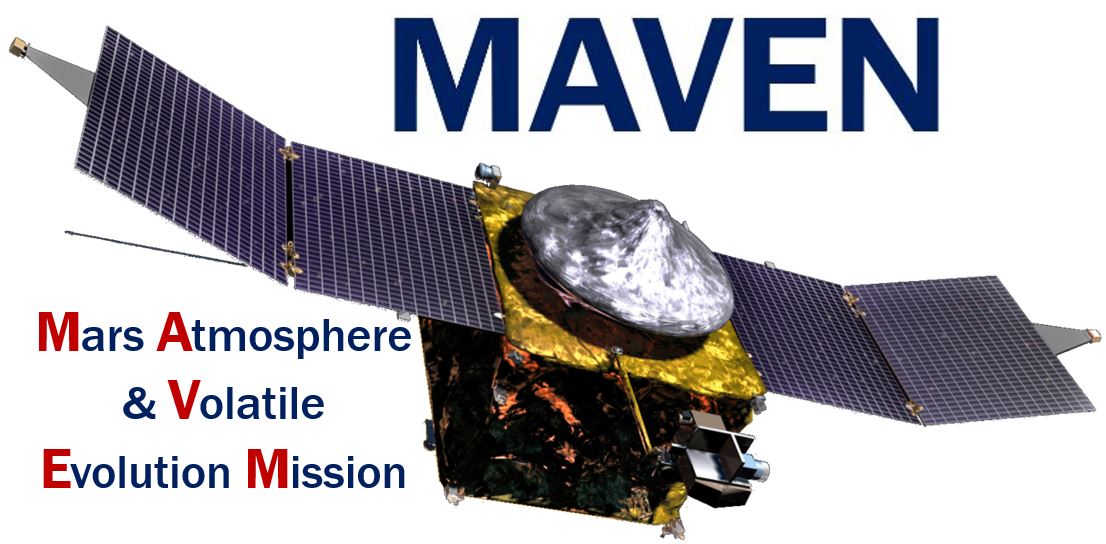Mars lost its atmosphere, which was blown into space by solar wind and radiation, NASA scientists informed, after gathering and analyzing data from its MAVEN space craft. Over a period of billions of years, the red planet was stripped of CO2 and argon in a process known as ‘sputtering’ – which literally means being physically knocked into outer space.
Mars, which used to be a warm, atmosphere-rich, wet planet capable of supporting life as we know it, is today a red, barren, wasteland – a desert world.
MAVEN, which stands for Mars Atmosphere and Volatile Evolution Mission, is a NASA space probe designed to study the atmosphere of Mars while it orbits the Red Planet. The mission’s objectives include finding out how the planet’s water and atmosphere, believed to have once been considerable, were lost over time.
 An artist’s impression of a young Mars (right) – believed to have abundant water and a much thicker atmosphere – vs. the dry, cold environment we see at the Red Planet today (left). (Image: NASA’s Goddard Space Flight Center)
An artist’s impression of a young Mars (right) – believed to have abundant water and a much thicker atmosphere – vs. the dry, cold environment we see at the Red Planet today (left). (Image: NASA’s Goddard Space Flight Center)
Mars atmosphere lost to space
Bruce Jakosky, lead investigator for MAVEN, based at the University of Colorado in Boulder, said:
“We’ve determined that most of the gas ever present in the Mars atmosphere has been lost to space.”
Jakosky and colleagues determined that approximately sixty-five percent of all the argon that was ever in Mars’ atmosphere ended up in outer space.
Jakosky was lead author in an article – ‘Mars’ atmospheric history derived from upper-atmosphere measurements of 38Ar/36Ar’ – which was published in the journal Science today (31st March, 2017).
In an Abstract preceding the main article, the authors wrote:
“A large fraction of Mars’ atmospheric gas has been lost to space, contributing to the transition in climate from an early, warm, wet environment to today’s cold, dry atmosphere.”
Evidence water was once abundant on Mars
Liquid water, which is vital for life as we know it, is not stable on the surface of Mars today, because its atmosphere is far too thin and cold to support it. However, there is evidence of dry riverbeds and minerals that only form when there is liquid water around.
 In 2015, scientists from the European Space Agency and NASA said that 4.3 billion years ago Mars had so much water that it probably covered most of the planet in a massive ocean about 460 feet (140 meters) deep. (Image: eso.org)
In 2015, scientists from the European Space Agency and NASA said that 4.3 billion years ago Mars had so much water that it probably covered most of the planet in a massive ocean about 460 feet (140 meters) deep. (Image: eso.org)
This evidence suggests that the Red Planet’s climate was very different a long time ago – probably warm enough for water to flow on the surface for extremely long periods.
Elsayed Talaat, a MAVEN Program Scientist who works at NASA’s headquarters in Washington, explained:
“This discovery is a significant step toward unraveling the mystery of Mars’ past environments. In a broader context, this information teaches us about the processes that can change a planet’s habitability over time.”
How Mars lost its atmosphere
A planet can lose it atmosphere through chemical reactions, erosion by radiation, and stellar wind from its parent star – which in this case would be our Sun.
According to the latest MAVEN data, radiation and solar wind were responsible for the disappearance of much of Mars’ atmosphere.
Solar wind is a continuous thin stream of electrically-conducting gas that blows out from the Sun’s surface.
 MAVEN was launched aboard an Atlas V launch vehicle on November 18th, 2013. It reached Mars on September 22, 2014, and was inserted into an areocentric elliptic orbit 3,900 miles (6,200 km) by 93 miles (150 km) from the Red Planet’s surface. It is thanks to the data gathered from this probe that scientists can now conclude why Mars’ atmosphere deteriorated. (Image: Wikipedia)
MAVEN was launched aboard an Atlas V launch vehicle on November 18th, 2013. It reached Mars on September 22, 2014, and was inserted into an areocentric elliptic orbit 3,900 miles (6,200 km) by 93 miles (150 km) from the Red Planet’s surface. It is thanks to the data gathered from this probe that scientists can now conclude why Mars’ atmosphere deteriorated. (Image: Wikipedia)
Billions of years ago, the Sun’s solar wind and ultraviolet radiation were far more intense than they are today. The atmospheric loss by these processes was considerably greater in Mars a long time ago.
Microbial life may have existed once on the Red Planet, the scientists believe. However, as it dried up and cooled off, any life would either have been forced into rare surface oases or underground.
Jakosky and colleagues obtained the new result by measuring how abundant two different isotopes of argon gas were. Isotopes are atoms with different mass but of the same element.
The lighter of the two isotopes more readily escapes into space. This means that the gas remaining behind will be richer in the heavier isotope.
The scientists used the two isotope’s relative abundance at Mars’ surface and upper atmosphere to estimate how much of the atmospheric gas had been lost to space.
#MAVEN Reveals Speed of Solar Wind Stripping Mars’ Atmosphere https://t.co/ikxwCaxz2g VIDEO: https://t.co/fl4OrJT5mb pic.twitter.com/hFLUihGyeB
— NASA’s MAVEN Mission (@MAVEN2Mars) November 5, 2015
Argon – the noble gas
‘Noble’ gases cannot be sequestered in rocks – the only way they can vanish is through a physical process known as ‘sputtering’ by solar wind. In the sputtering process, ions picked up by the solar wind can physically knock atmospheric gas into outer space. Argon is a noble gas.
The researchers tracked argon because it can only vanish as a result of sputtering. As soon as they determined how much argon had been lost by sputtering, they could use this data to determine the sputtering loss of other molecules and atoms, including CO2 (carbon dioxide).
C02 is an efficient greenhouse gas – it retains heat and warms a planet. C02 is the major constituent of the Red Planet’s atmosphere; hence the interest.
The authors made this estimate using data from the upper atmosphere of Mars, which was gathered by MAVEN’s NGIMS (Neutral Gas and Ion Mass Spectometer). They also gathered data from NASA’s SAM (Sample Analysis of Mars) instrument onboard the Curiosity rover.
Co-author Paul Mahaffy, of NASA’s Goddard Space Flight Center in Greenbelt, Maryland, said:
“The combined measurements enable a better determination of how much Martian argon has been lost to space over billions of years. Using measurements from both platforms points to the value of having multiple missions that make complementary measurements.”
Mahaffy is principal and lead investigator of the SAM and NGIMS instruments respectively – both were developed at NASA Goddard.
The study was funded by the MAVEN mission.
Video – Mars Atmosphere Loss: Sputtering
This NASA Goddard video explains how Mars, once a warm and wet planet, lost its early atmosphere.
